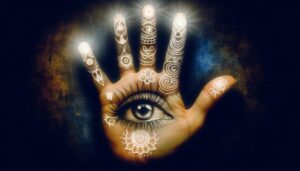What Is the Meaning of the Black Heart Symbol in Modern Communication?
The black heart symbol, rooted in ancient symbolism, embodies a spectrum of profound human emotions and societal constructs. Historically linked to mourning and solemnity, it acknowledges the depth of grief and loss.
In romantic contexts, it signifies intense, resilient love, shrouded in mystery and sophistication. The symbol also resonates within gothic culture, reflecting an appreciation for darkness and melancholy.
In modern digital communication, it is utilized to convey dark humor, defiance, and emotional resilience. Present in fashion and pop culture, the black heart continues to be a versatile emblem of emotional depth and personal expression.
Explore further to uncover its multifaceted meanings.
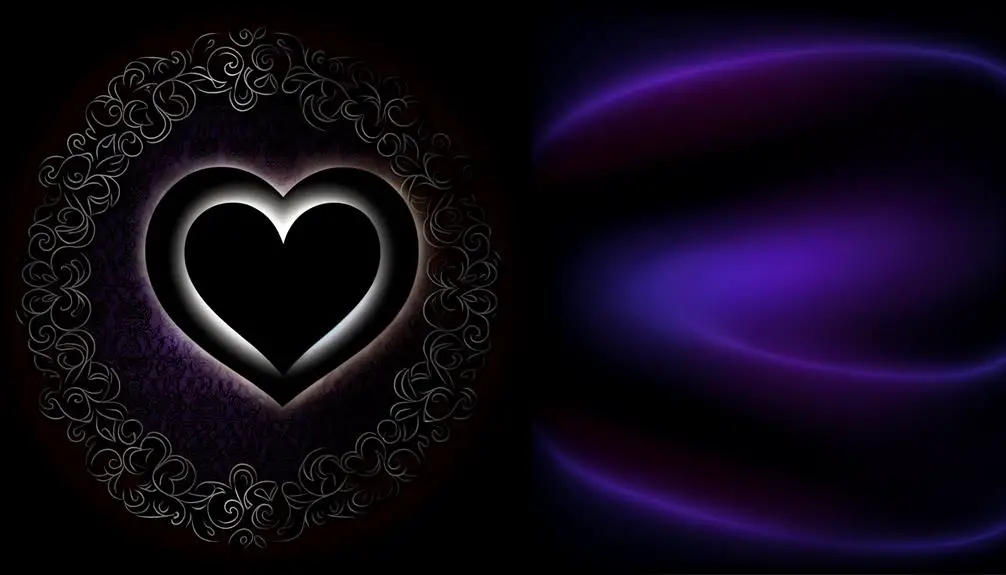
Key Takeaways
- Symbolizes grief, mourning, and the emotional weight of loss.
- Represents deep romantic love with an emphasis on intensity and mystery.
- Embraces dark humor, resilience, and acceptance of life's darker facets.
- Reflects gothic culture's appreciation for the macabre and melancholy.
- Communicates sophistication and rebellion in modern social media and fashion contexts.
Historical Origins
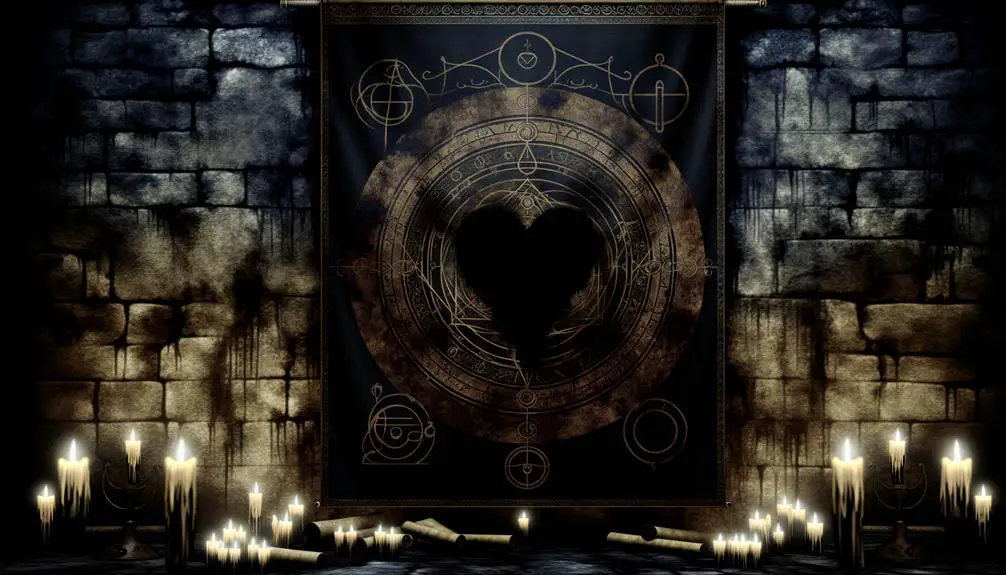
Rooted in ancient symbolism, the black heart has historically represented a range of complex human emotions and societal constructs. From mourning and loss to rebellion and strength, this symbol has carried diverse meanings throughout different cultures and time periods.
In early civilizations, such as ancient Egypt, black was associated with the afterlife, reflecting both the fear and reverence of death. The color black symbolized the unknown and the mysteries of the beyond, instilling a sense of awe and respect for the departed.
During the Middle Ages in Europe, black attire was customary for mourning. This practice symbolized solemnity and the finality of life, emphasizing the somber nature of death and the process of grieving. The black heart, in this context, represented the deep sorrow and introspection that accompany loss.
Meanwhile, in literature and art, the black heart evolved as a metaphor for deep emotional and existential struggles. Writers and artists used this symbol to convey the complexities of human experience, exploring themes of darkness, despair, and inner turmoil.
This potent symbol also found resonance in various cultural rebellions, embodying defiance against established norms. The black heart became a powerful emblem of resistance and nonconformity, challenging societal expectations and advocating for change.
Hence, the black heart's historical journey reveals its multifaceted role in expressing profound human experiences and societal dynamics. It serves as a timeless symbol of the human condition, encapsulating the depth and complexity of our emotions, beliefs, and aspirations.
Emotional Significance
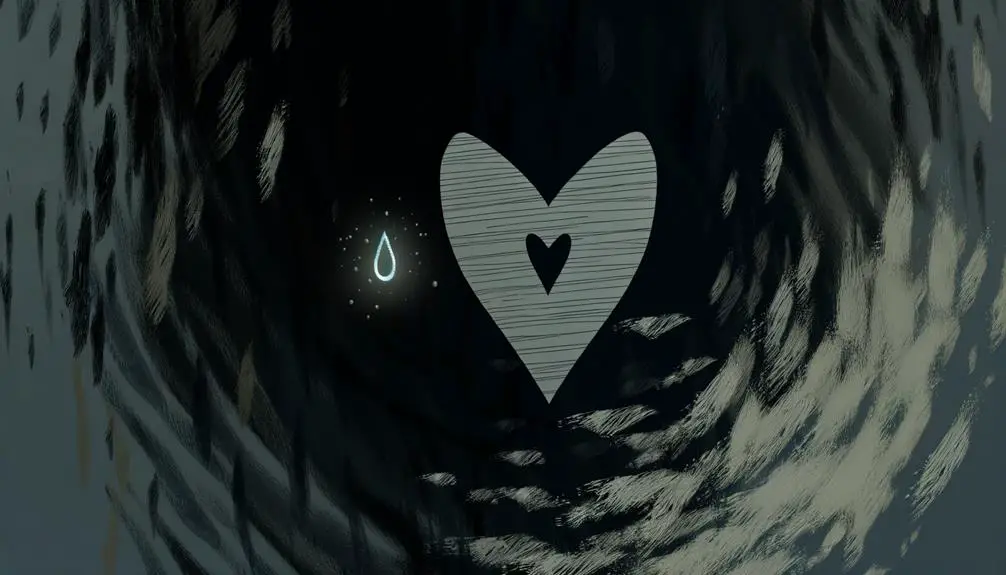
The black heart symbol, while historically associated with themes of grief and mourning, has evolved to encapsulate a spectrum of emotional nuances. It often represents deep romantic love imbued with complexity, challenging conventional expressions of affection.
Additionally, its incorporation in dark humor illustrates a cultural shift towards embracing irony and unconventional emotional expressions.
Grief and Mourning
Symbolizing the profound depths of grief and mourning, the black heart emoji encapsulates the emotional weight often associated with loss and sorrow in digital communication. Historically, black has been a color intrinsically linked to mourning and solemnity, dating back to ancient Roman and Victorian eras where black attire signified bereavement.
In contemporary society, this symbolism has seamlessly evolved into digital forms of expression. The black heart emoji provides a nuanced means of conveying grief, offering a visual representation of the heavy, often indescribable emotions tied to mourning. Its usage goes beyond mere words, providing a shared visual language that acknowledges the profound human experience of loss.
This digital symbol plays a critical role in modern emotional expression.
Deep Romantic Love
In the domain of deep romantic love, the black heart emoji extends its significance to embody the intensity and depth of passionate emotions that often accompany profound romantic connections.
Historically, black has been associated with mystery and sophistication, aspects that can parallel the complexities of deep romantic bonds. This symbol transcends mere affection, delving into the realms of fervent, sometimes tumultuous, emotional experiences.
The black heart may hence signify a love that is both ardent and resilient, capable of enduring through the darker, more challenging aspects of a relationship. This emblem serves as a tribute to the multifaceted nature of love, encapsulating not just joy and warmth, but also the shadows and depths that make romantic connections truly profound.
Dark Humor Usage
Often intertwined with the nuances of dark humor, the black heart symbol has come to represent a form of emotional resilience and defiance in the face of life's absurdities.
Historically, dark humor has served as a coping mechanism, allowing individuals to confront grim realities through a veil of irony and wit. The black heart, in this perspective, signifies an acceptance of life's darker facets while maintaining an undercurrent of strength and endurance.
It encapsulates a complex emotional landscape where pain and humor coexist, offering a shield against vulnerability. This emblematic use underscores the human capacity to find levity in sorrow, transforming the black heart into a poignant symbol of fortitude and existential acknowledgment.
Grief and Mourning
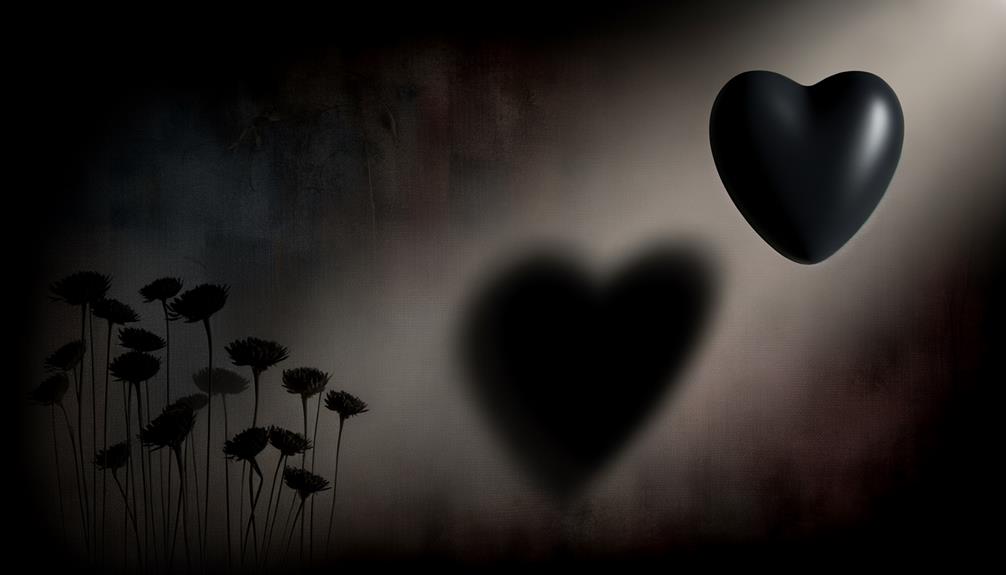
Throughout history, the black heart symbol has been intricately associated with the profound expressions of grief and mourning, reflecting the depths of human sorrow and the cultural practices surrounding loss. This emblem has transcended eras and societies, symbolizing the emotional void left by the departure of loved ones.
Historically, it has been employed in various contexts, such as:
- Victorian Mourning Jewelry: Adorned by those in bereavement, signifying eternal love and loss.
- Literary Works: Used metaphorically to describe profound grief and heartache.
- Funeral Attire: Black attire, including heart-shaped brooches, to denote mourning status.
- Digital Communication: Modern usage in text messages to convey sympathy and solidarity.
The black heart remains a potent symbol in articulating the timeless human experience of mourning.
Dark Humor
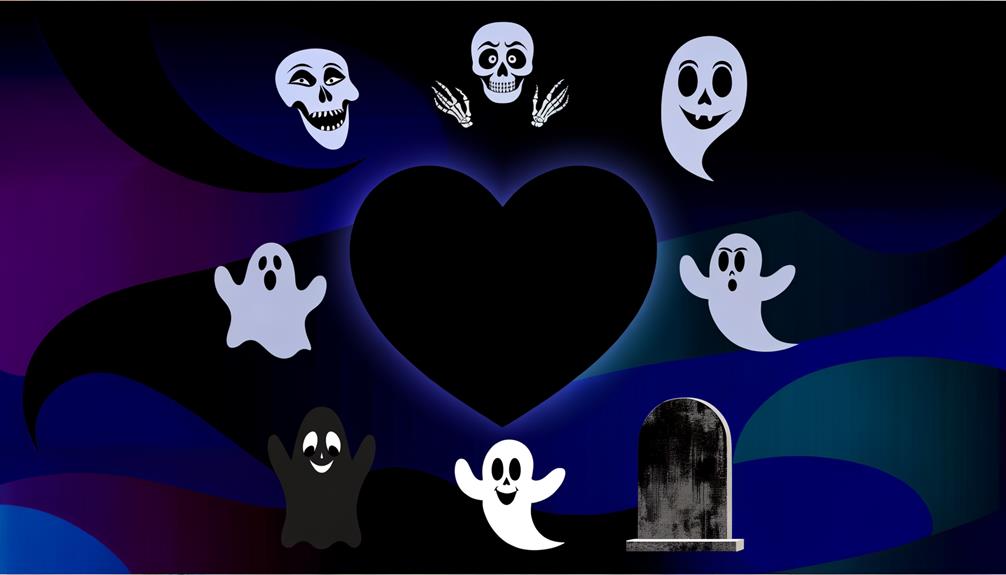
The black heart symbol, when associated with dark humor, signifies the unexpected comic relief found in otherwise grim or morbid situations. This twisted sense of humor often employs irony and sarcasm as mechanisms to cope with distressing realities, reflecting a historical tradition of finding levity amidst adversity.
Such usage underscores the complex interplay between humor and human resilience, revealing how the black heart can articulate a nuanced, albeit unconventional, form of emotional expression.
Unexpected Comic Relief
Dark humor, characterized by its ability to juxtapose grim subjects with a comedic twist, finds an unexpected yet profound representation in the black heart symbol.
Historically, dark humor has served as a coping mechanism during tumultuous times, often providing comic relief through its stark contrast to prevailing sentiments. The black heart encapsulates this dichotomy, symbolizing:
- Mourning intertwined with irony: It conveys sorrow but with a hint of sardonic detachment.
- Acceptance of mortality: Acknowledging death's inevitability with a wry smile.
- Subversion of traditional symbols: Turning the classic red heart's connotation of love on its head.
- Emotional complexity: Reflecting the multifaceted nature of human experiences.
In essence, the black heart symbol adeptly encapsulates dark humor's role in navigating life's darker moments.
Twisted Sense of Humor
Emerging from a complex interplay of societal taboos and the human psyche, dark humor—often termed a twisted sense of humor—offers a unique lens through which to examine the paradoxes of existence.
Historically, dark humor has served as a coping mechanism, providing catharsis for individuals confronting mortality, suffering, and the absurdity of life. Philosophers such as Arthur Schopenhauer and existentialists like Jean-Paul Sartre have explored its utility in addressing existential angst.
This form of humor functions by juxtaposing grim subject matter with levity, challenging conventional norms and provoking reflection on deeply ingrained fears and anxieties.
The black heart symbol, when used in this context, embodies a nuanced expression of this complex emotional and intellectual interplay.
Irony and Sarcasm
Intertwining irony and sarcasm, dark humor often employs a sophisticated interplay of wit and subtext to navigate the complexities of human experience. Historically, dark humor has served as a coping mechanism, allowing individuals to confront grim realities with a veneer of detachment.
The black heart symbol, often used in digital communication, encapsulates this nuanced form of expression. Its usage reflects a modern evolution of dark humor, seamlessly blending irony and sarcasm to convey sentiments that might otherwise be difficult to articulate.
- Represents a cynical view of love or life
- Signals a playful yet dark sense of humor
- Acts as a social commentary on contemporary issues
- Conveys emotional complexity with a touch of irony
Understanding this symbol requires an appreciation of its layered meanings.
Gothic Culture
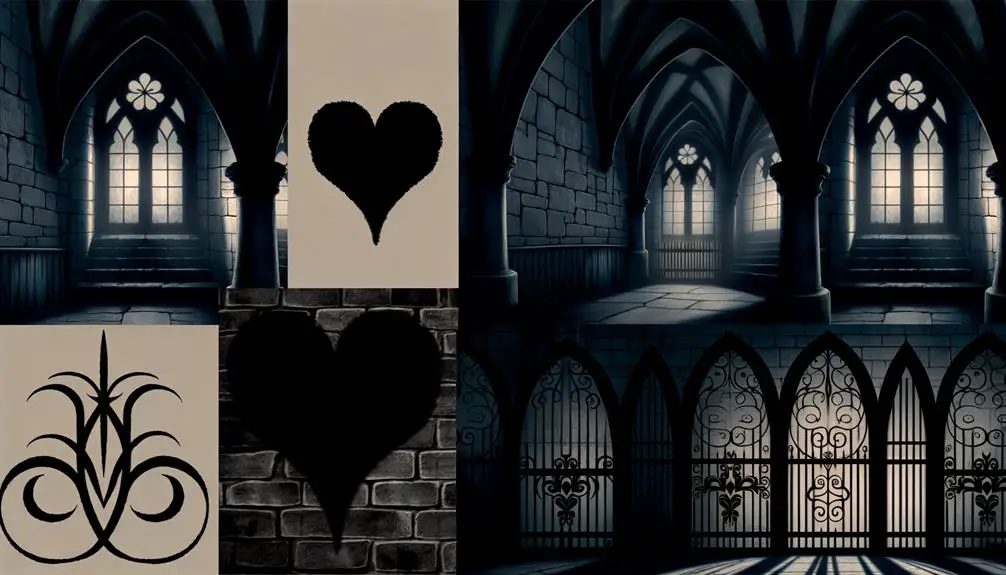
Gothic culture, deeply rooted in the late medieval period and characterized by its distinct aesthetic and philosophical underpinnings, has continuously influenced modern interpretations of the black heart symbol.
Emerging during the 12th century, Gothic architecture and literature emphasized themes of darkness, decay, and romanticism, which resonated with the human condition's more somber aspects. This cultural movement fostered an appreciation for the macabre and the melancholic, elements that the black heart symbol encapsulates.
As Gothic culture evolved, it maintained a fascination with the dichotomy of beauty and morbidity, an ethos that the black heart represents. Therefore, the symbol is not merely an emblem of sorrow or mourning but a complex representation of Gothic values, intertwining beauty with existential contemplation.
Fashion and Style

In the world of fashion and style, the black heart symbol has transcended its historical roots to become a versatile emblem of contemporary aesthetics and identity. Historically aligned with themes of melancholy and rebellion, the black heart now signifies a sophisticated blend of elegance and edge.
This transformation is evident in various facets of fashion:
- High Fashion Collections: Prominent designers incorporate the black heart in haute couture, symbolizing modern romanticism.
- Streetwear: The symbol is prevalent in urban fashion, representing a blend of authenticity and resilience.
- Jewelry: Black heart motifs in accessories convey a sense of mystery and individuality.
- Tattoos: As a body art choice, the black heart stands for personal stories and emotional depth.
This multifaceted symbol continues to evolve, shaping and reflecting modern style.
Social Media Usage
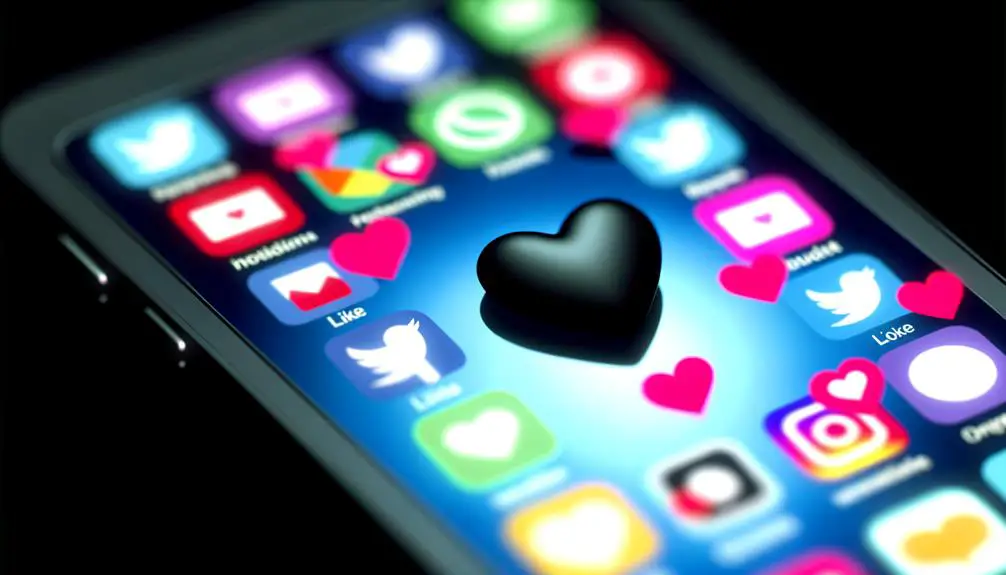
As the black heart symbol permeates various facets of fashion and style, its presence on social media platforms underscores a broader cultural resonance and digital expression.
Historically, the black heart has transcended its conventional associations with mourning and sorrow, evolving into a versatile emblem of complex emotions.
On platforms like Instagram and Twitter, the black heart is frequently employed to communicate sentiments of sophistication, rebellion, or deep affection tinged with melancholy. This multifaceted usage reveals the digitized era's penchant for nuanced emotional expression.
Additionally, the black heart often complements thematic aesthetics, aligning with dark, minimalist, or avant-garde visual narratives. Hence, its widespread adoption on social media highlights the symbol's adaptability and profound impact on modern digital communication.
Pop Culture References
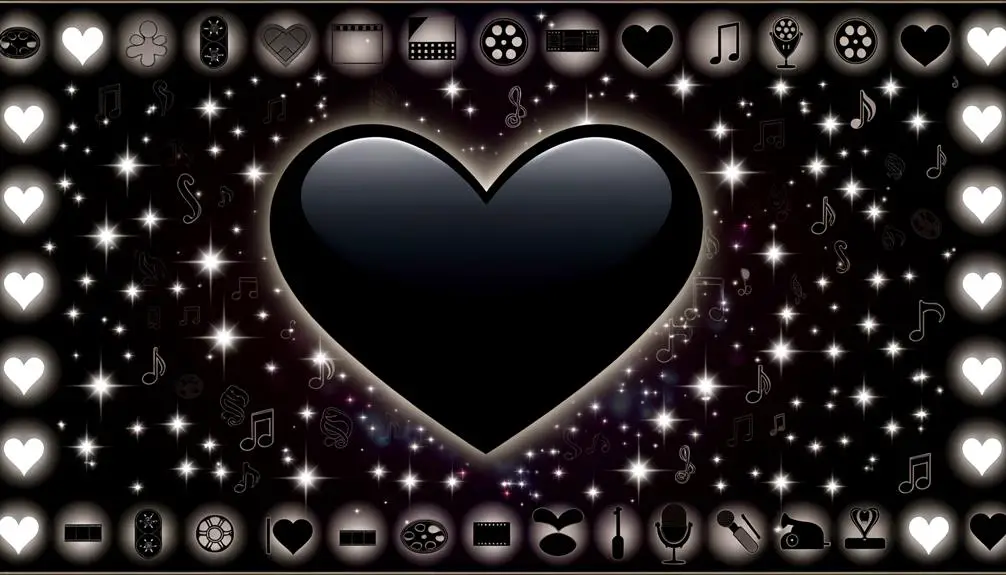
Although often associated with darker themes, the black heart symbol has also become a prominent fixture in pop culture, representing a diverse range of meanings and emotional undertones in various media, from music and film to literature and fashion.
Historically, the black heart has transcended its initial connotations, evolving into a multifaceted emblem. In music, it frequently appears in lyrics and album art to convey complex emotions.
- Music: Used in song titles and lyrics to reflect themes of heartbreak and resilience.
- Film: Symbolizes characters' inner turmoil or anti-hero personas.
- Literature: Represents darker narrative elements or character traits.
- Fashion: Adopted in gothic and alternative styles to signify depth and rebellion.
These varied uses illustrate the symbol's rich, evolving semiotic landscape.
Personal Expression

How has the black heart symbol evolved into a powerful tool for personal expression, transcending its traditional associations to encompass a broad spectrum of individual emotions and identities?
Historically linked to sorrow and morbidity, the black heart has undergone a transformative journey.
In contemporary digital communication, it now serves as a multifaceted emblem. Individuals employ it to convey complex feelings such as deep affection, existential contemplation, or even subcultural affiliations.
Its versatility enables users to articulate nuanced sentiments that traditional symbols may fail to capture.
This evolution aligns with the broader trend of emojis becoming essential tools for nuanced, personalized communication, reflecting the fluidity and diversity of human emotional landscapes in the digital age.
Conclusion
The black heart symbol, a multifaceted emblem, weaves through the tapestry of human emotion and cultural expression.
From its historical roots to contemporary digital landscapes, it serves as a beacon for grief, a vessel for dark humor, and a badge of gothic identity.
This enigmatic icon, cloaked in shades of sorrow and style, encapsulates the complexities of modern sentiment.
Its resonance in fashion, social media, and pop culture underscores its enduring, chameleonic allure.



